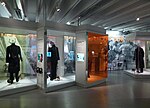Nasdaq Stockholm
1998 mergers and acquisitions2003 mergers and acquisitions2008 mergers and acquisitionsBusiness organizations based in SwedenCompanies based in Stockholm ... and 7 more
Economy of StockholmFinance in SwedenFinancial services companies established in 1863Nasdaq NordicNasdaq exchangesStock exchanges in EuropeSwedish companies established in 1863

Nasdaq Stockholm, formerly known as the Stockholm Stock Exchange (Swedish: Stockholmsbörsen), is a stock exchange located in Frihamnen, Stockholm, Sweden. Founded in 1863, it has become the primary securities exchange of the Nordic countries. As of March 2021, a total of 832 companies are listed on Nasdaq Stockholm with 385 companies on the main market and additional 447 listed on secondary markets (Nasdaq First North and Nasdaq First North Premier).
Excerpt from the Wikipedia article Nasdaq Stockholm (License: CC BY-SA 3.0, Authors, Images).Nasdaq Stockholm
Palermogatan, Stockholm Ladugårdsgärdet (Östermalms stadsdelsområde)
Geographical coordinates (GPS) Address Nearby Places Show on map
Geographical coordinates (GPS)
| Latitude | Longitude |
|---|---|
| N 59.3401 ° | E 18.1215 ° |
Address
Nasdaq OMX
Palermogatan
115 56 Stockholm, Ladugårdsgärdet (Östermalms stadsdelsområde)
Sweden
Open on Google Maps











